Yeticom Optima AM/FM/SSB 10 Meter ExportReview
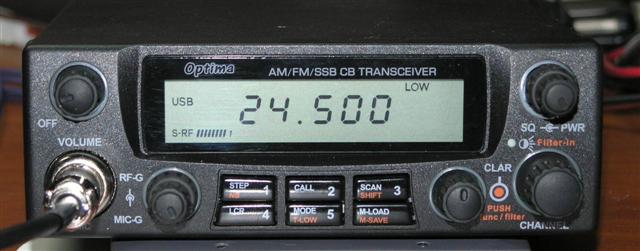
OPTIMA 10-12m Radio from YeticomNZ
Special thanks to our friends in the Southern Hemisphere for providing this review.
We just recently received the new YeticomNZ Optima radio and put it through its paces. It was not modified in any way and we used it straight out of the box. In most ways this radio functions similarly to the Radio Shack HTX-10 style of radios which have also been released under many other brand names and continue to be sold until today. Most I think are made in the Philippines but this one is made in China.
From the outside they all look the same. 5 knobs, 6 buttons and a front mic connector. On the back a heat sink, power lead and extension speaker.
The Radio
There are several crucial differences in the way this radio functions that make it quite different to the other radios using this design. Firstly, the radio does NOT need to be connected up to the power to retain the memory functions and settings. It doesn’t have a battery either. Once you program them they are there till you change them.
MODES
The radio has 4 modes which can be set from an internal jumper on the main board behind the mic socket. There are four positions and only one should be jumpered depending on the characteristics of the radio required. The available options are:
1. Freeband Mode. The radio is open from 24.5 to 29.995 with all functions. 5khz step default. Frequency read out only. Press Call (button 2) to step up in 1mhz steps.
2. Ham Mode 24.5mhz to 25.000 and 28.000 to 29.995. 5khz step default. Press call (button 2) to toggle between bands.
3. 40 channel US CB band. 10khz steps. func and call toggles between channel read out and frequency.
4. 40 channel NZ CB Band (26330-26.770mhz) in 10khz steps. Func and call to toggle between channel read out and frequency.
Jumpers on main board behind Microphone Socket.
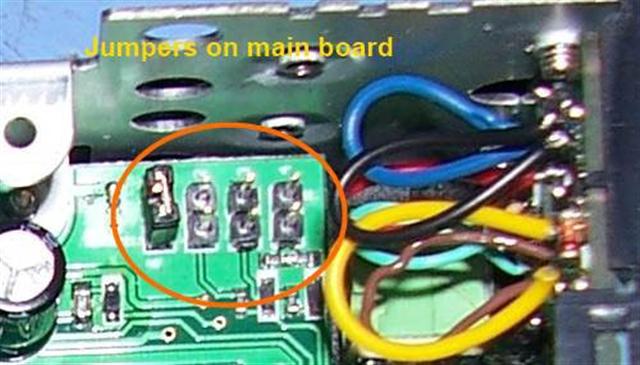
We still have the 40 channel CB frequencies with the channels but the only way to access this is by setting the jumper and then you only have a 50w CB radio until you change the jumper setting. The 10m band of the original radios appears to have been expanded to encompass the entire range of the radio. This is now the freeband mode and how the radios are normally shipped.
Alternately we have a fully functional (street legal?) ham radio setting as well.
To change the operating mode you have to open the radio and change a jumper.
OPERATION
I will discuss the radio in the fully open freeband mode. The ham setting is almost the same except the call button toggles 10 and 12 meter bands where on the freeband mode it steps up in 1mhz steps. There are no 40 channel bands on this radio at all when in the freeband mode. There is just one big band from 24.5mhz to 29.999 mhz. Use the call (button 2) to step up quickly in 1mhz steps. The 5 memories are there and the input and output method has not changed. 3 steps to save and 2 steps to retrieve.
The most significant improvement is the 5khz default step. This really makes this radio simple to use. In the past you either kept a zero frequency in memory or had to use the step function to change from a frequency ending in zero to a frequency ending in five. If you live around 27.555 then it always took some clicks to QSY from 27.555 (where most of the stations would be calling) to 27.550 or any other frequency ending in a zero. With the 5khz steps turn the selector knob, or the up /down buttons on the microphone.
Another change is in the way the step function works. if you set the step for 1khz it keeps stepping in 1khz till you do something like depress the PTT (or anything else) when it reverts to the default 5khz step. It does not rotate around a 10khz bandwidth. Frankly I would prefer it to remain in 1khz steps if that’s what it was set to. However, that’s how it is set. Perhaps that will change on later models. The 10khz and 100khz steps work the same as the 1khz steps and you can flick through the entire frequency range in whatever step you have set.
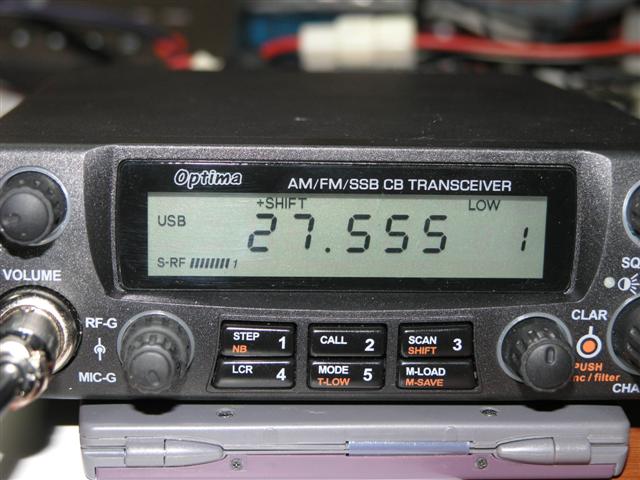
Memories.
5 memories input takes function and 2 button clicks. Recall two button clicks. The func and button 4 will scan just the memories. Very handy.
Shift.
Shift works from 24.5 to 29.995 as long as you don’t set it so it falls out side the bandwidth of the radio.
It can be adjusted from 5khz to 1mhz. plus or minus shift.
Filter.
An additional narrow IF filter has been fitted to this radio but the I don’t like the method of turning it on and off. One must press and hold the func button for three seconds. It should be an instant button press. It takes too long to turn it on and off. On the bright side it certainly cleans up the signal and drops the noise, but you may find you need to increase the volume to compensate.
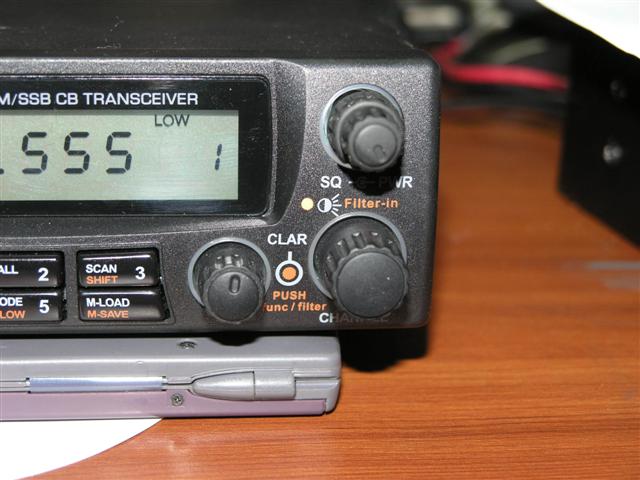
Finals
2ea IRF520 mosfets in a shielded box and a fan on the heatsink. Fan ran when PTT depressed and continued for about 30 seconds after it was released.
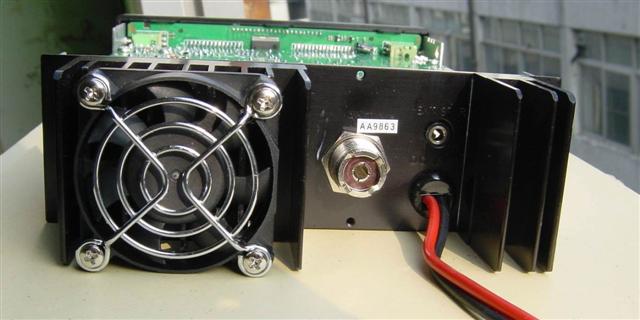
The heatsink never got warm to touch. Out of the box the Output power was 45w on SSB, 40 on FM and 14 AM carrier talking to
40w on voice peaks. Power control works on all modes, but hit full power before the control was increased 50%.
Microphone
The microphone is small. Some people won’t like it. It is mated to an 8 pin Icom compatible plug. It did work very well with the JCD201M desk mic and Icom cable, the transmitted audio being slightly louder and clearer in the desk mic’s FM mode and narrower and sharper in the microphone’s SSB mode. Did not attempt to try it on AM or FM.
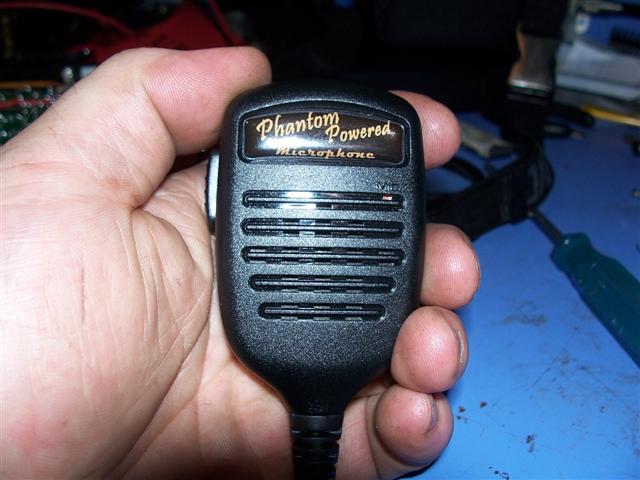
The trim pot has been removed from the supplied handheld microphone. The audio is set full in the radio so the mic gain may need to be reduced to suit some microphones. The radio uses an ECM type insert that needs voltage from the radio so care needs to be taken if using different microphones.
Receive
Receive was clean with plenty of volume and sensitivity. I found I needed to reduce the RF gain to reduce the signals under crowded conditions. Manufacturer states they have added 3-6db gain in the receive to boost weak signals under quiet band conditions. Certainly very sensitive and weaker stations did appear clearer and sharper.
Transmit
Transmit audio is good. Mid range. Clear and punchy. No problem to drive either the DX500 or the DX1600 amplifiers we tested it with.
Construction
As you can see from the pictures the layout is neat and tidy with very few wires running around the cabinet. The final stage is well shielded and the heatsink is cooled. Contrary to many mosfet final radios of similar power this radio did not heat up even under extended use. The fan worked and did it’s job silently.
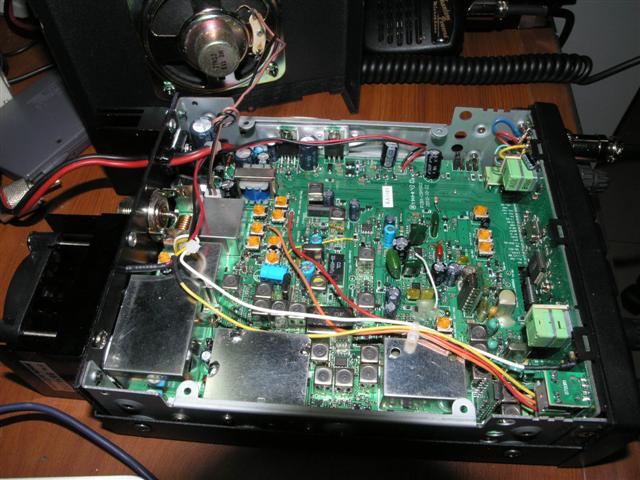
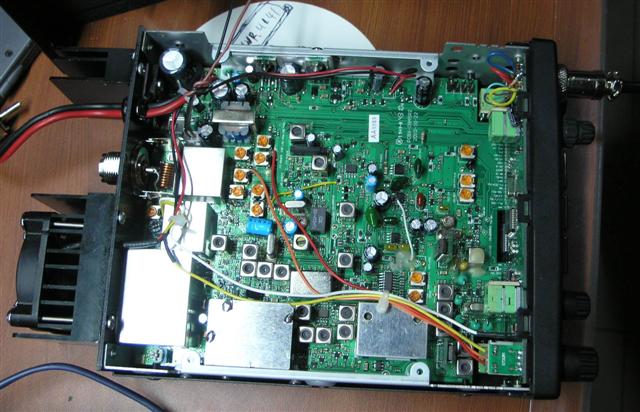
Conclusion
Small, powerful, neat, and easy to use. Good things do come in small packages!
CLICK HERE TO DOWNLOAD THE OPERATION MANUAL FOR THE YETICOM OPTIMA
_________________________________________________________________________________
OPTIMA
GENERAL SPECIFICATIONS
Frequency Coverage : Transmit and Receive ……………………………. 24.500 to 29.999 MHz
Antenna Impedance : 50 ohm, unbalanced
Frequency Control : Digital Phase-Lock Loop (PLL) Synthesizer
Frequency Accuracy : Better than +10 ppm from 0 – 40C after 15 min. warm up
Power Requirement : 12 – 13.8 V DC, negative ground
Current Consumption : 8 amps maximum
Dimensions : 6 x 2 x 9.5 in (W x H x D)
Weight : 2.9 lbs
Shipping weight : 2.050 Kg
TRANSMITTER SPECIFICATIONS
Power Output : SSB / FM………………………………………… 50 Watts PEP
: AM ………………………………………………….12 Watts Average / 50 Watts PEP
Tuning Steps : 1 kHz / 5khz / 10 kHz / 100 kHz (5khz default)
Final Transistors : IRF520 MOSFET (x2)
Spurious Emissions : More than 50 dB below peak output power
Carrier Suppression : More than 40 dB below peak output power
Unwanted Sideband : More than 50 dB below peak output (1 kHz tone)
FM Deviation : +/- 2 kHz maximum
Audio Response : More than 30dB below peak output
Frequency Response : 400 to 2800 Hz
Microphone Impedance : ECM, 600 to 1K ohms
RECEIVER SPECIFICATIONS
Circuit Type : Dual-Conversion Superheterodyne
Intermediate Frequencies
: 1st IF / SSB IF ………………………………………………………… 10.695 MHz
: 2nd IF …………………………………………………………………………. 455 kHz
Sensitivity : SSB……………………………………………………. 0.25 μV at 10 dB S + N/N
: AM ………………………………………………………. 1.0 μV at 10 dB S + N/N
: FM…………………………………………………………. 0.3 μV at 12 dB SINAD
Selectivity : SSB………………………………………… 4.2 kHz (-6 dB) / 8.5 kHz (-60 dB)
: AM / FM …………………………………… 6.0 kHz (-6 dB) / 18 kHz (-60 dB)
Clarifier Range : +/- 3.0 kHz
Adjacent Channel Rejection : Better than 70 dB (with further improvement when 2ndIF filter engaged)
IF Rejection : Better than 80 dB for all frequencies
Frequency Response : 250 to 3000 Hz
Audio Output Power : 2 watts minimum at 10% THD with an 8 ohm load
Audio Output Impedance : 8 ohms
